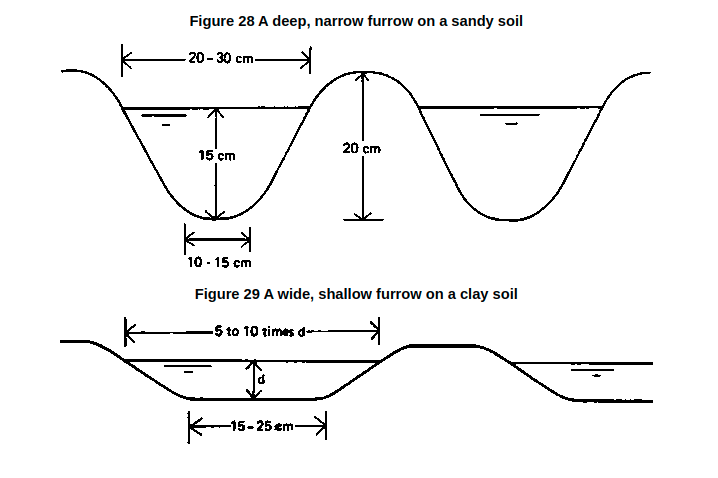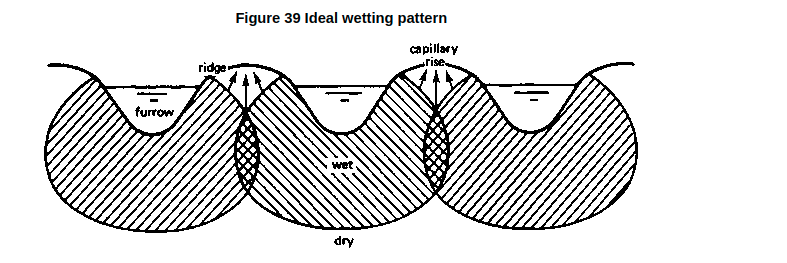CHAPTER 3. FURROW IRRIGATION
Furrows are small, parallel channels, made to carry water in order to irrigate the crop. The crop is usually grown on the ridges between the furrows (Figures 23 and 24).

3.1.1 Suitable crops
Furrow irrigation is suitable for many crops, especially row crops. Crops that would be damaged if water covered their stem or crown should be irrigated by furrows.
Furrow irrigation is also suited to the growing of tree crops. In the early stages of tree planting, one furrow alongside the tree row may be sufficient but as the trees develop then two or more furrows can be constructed to provide sufficient water. Sometimes a special zig-zag system is used to improve the spread of water (Figure 25).
Corrugation irrigation, frequently mentioned in literature, is a special type of furrow irrigation, used for broadcast crops. Corrugations are small hills pressed into the soil surface. The application of this method is limited and is not included in this manual.
In summary, the following crops can be Irrigated by furrow irrigation:
– row crops such as maize, sunflower, sugarcane, soybean;
– crops that would be damaged by inundation, such as tomatoes, vegetables, potatoes, beans;
– fruit trees such as citrus, grape;
– broadcast crops (corrugation method) such as wheat.
3.1.2 Suitable slopes
Uniform flat or gentle slopes are preferred for furrow irrigation. These should not exceed 0.5%. Usually a gentle furrow slope is provided up to 0.05% to assist drainage following irrigation or excessive rainfall with high intensity.
Slope
Although furrows can be longer when the land slope is steeper, the maximum recommended furrow slope is 0.5% to avoid soil erosion. Furrows can also be level and are thus very similar to long narrow basins. However a minimum grade of 0.05% is recommended so that effective drainage can occur following irrigation or excessive rainfall. If the land slope is steeper than 0.5% then furrows can be set at an angle to the main slope or even along the contour to keep furrow slopes within the recommended limits. Furrows can be set in this way when the main land slope does not exceed 3%. Beyond this there is a major risk of soil erosion following a breach in the furrow system. On steep land, terraces can also be constructed (see Basin Irrigation) and furrows cultivated along the terraces.
Soil type
In sandy soils water infiltrates rapidly. Furrows should be short (less than 110 a), so that water will reach the downstream end without excessive percolation losses.
In clay soils, the infiltration rate is much lower than in sandy soils. Furrows can be much longer on clayey than on sandy soils. The determination of the infiltration rate is explained in Annex 2.
Stream size
Normally stream sizes up to 0.5 l/sec will provide an adequate irrigation provided the furrows are not too long. When larger stream sizes are available, water will move rapidly down the furrows and so generally furrows can be longer. The maximum stream size that will not cause erosion will obviously depend on the furrow slope; in any case, it is advised not to use stream sizes larger than 3.0 l/sec (see Table 3).
Irrigation depth
Applying larger irrigation depths usually means that furrows can be longer as there is more time available for water to flow down the furrows and infiltrate.
Cultivation practice
When the farming is mechanized, furrows should be made as long as possible to facilitate the work. Short furrows require a lot of attention as the flow must be changed frequently from one furrow to the next. However, short furrows can usually be irrigated more efficiently than long ones as it is much easier to keep the percolation losses low.
Field length
It may be more practical to make the furrow length equal to the length of the field, instead of the ideal length, when this would result In a small piece of land left over (Figure 27). Equally the length of field may be much less than the maximum furrow length. This is not usually a problem and furrow lengths are made to fit the field boundaries.
3.2.2 Furrow shape
The shape of furrows is influenced by the soil type and the stream size.
Soil type
In sandy soils, water moves faster vertically than sideways (= lateral). Narrow, deep V-shaped furrows are desirable to reduce the soil area through which water percolates (Figure 28). However, sandy soils are less stable, and tend to collapse, which may reduce the irrigation efficiency.
In clay soils, there is much more lateral movement of water and the infiltration rate is much less than for sandy soils. Thus a wide, shallow furrow is desirable to obtain a large wetted area (Figure 29) to encourage infiltration.

Stream size
In general, the larger the stream size the larger the furrow must be to contain the flow.
3.2.3 Furrow spacing
The spacing of furrows is influenced by the soil type and the cultivation practice.
Soil type
As a rule, for sandy soils the spacing should be between 30 and 60 cm, i.e. 30 cm for coarse sand and 60 cm for fine sand.
On clay soils, the spacing between two adjacent furrows should be 75-150 cm. On clay soils, double-ridged furrows – sometimes called beds – can also be used. Their advantage is that more plant rows are possible on each ridge, facilitating manual weeding. The ridge can be slightly rounded at the top to drain off water that would otherwise tend to pond on the ridge surface during heavy rainfall (Figure 30).
3.4 Irrigating Furrows
When there is a water shortage, it is possible to limit the amount of irrigation water applied by using ‘alternate furrow irrigation’. This involves irrigating alternate furrows rather than every furrow. Figure 37 is an example of this procedure. Instead of irrigating every furrow after 10 days, furrows 1, 3, 5, etc. are irrigated after 5 days and furrows 2, 4 and 6, etc. are irrigated after 10 days. Thus the crop receives some water every 5 days instead of a large amount every 10 days. Small amounts applied frequently in this way are usually better for the crop than large amounts applied after longer intervals of time.
In order to obtain a uniformly wetted rootzone, furrows should be properly spaced, have a uniform slope and the irrigation water should be applied rapidly.
As the root zone in the ridge must be wetted from the furrows, the downward movement of water in the soil is less important than the lateral (or sideways) water movement. Both lateral and downward movement of water depends on soil type as can be seen in Figure 38.

Ideal wetting pattern
In an ideal situation adjacent wetting patterns overlap each other, and there is an upward movement of water (capillary rise) that wets the entire ridge (see Figure 39), thus supplying the root zone with water.

f the furrow spacing is too wide (Figure 40) then the root zone will not be adequately wetted. The spacing of furrows needs careful selection to ensure adequate wetting of the entire root zone (Figure 40).


Suggested further reading
General
Jensen M.E. 1983 (ed). Design and operation of farm irrigation systems. Revised Printing. Amer. Soc. Agr. Engr. Mono. No. 3. St. Joseph, Michigan. 840 p.
Stern P.H. 1979 Small Scale Irrigation: A Manual of Low Cost Water Technology. Intermediate Technology Publications, London.
Withers B. and Vipond S. 1974 Irrigation: Design and Practice. (1st ed.). Batsford, London.
Surface Irrigation
Booher L.J. 1974 Surface Irrigation. Land and Water Development Division, FAO, Rome.
Kay M. 1986 Surface Irrigation: Systems and Practice. Cranfield Press, Bedford, UK.
Sprinkler Irrigation
Kay M. 1983 Sprinkler Irrigation: Equipment and Practice. Batsford, London.
Drip Irrigation
Nakayoma F.S. and Bucks D.A. 1986 (eds). Trickle Irrigation for Crop Production: Design, Operation and Management. Elsevier, New York. 393 p.
Vermeiren L. and Jobling G.A. 1980 Localized irrigation: design, installation, operation and evaluation. Irrigation and Drainage Paper 36, FAO, Rome.
M/S8684E/1/11.88/3500
https://www.fao.org/3/s8684e/s8684e00.htm#Contents
Leave a Reply
You must be logged in to post a comment.